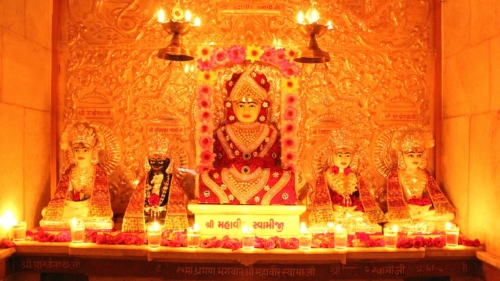SINDOOR or MAANG TIKA: Why Indian Women put in their Maang?
‘Maang Tika’ or ‘Sindoor’ is a symbol of Hindu married women. It represents a symbol of fertility, prosperity, peace and happiness, the saubhagya’. , the female energy. The colour ‘red’ symbolizes fertility and prosperity, the colour of love and passion, and strength. Hence, Sindoor adds a divine beauty to a
married woman, who transforms into a responsible wife from a free-spirited girl.
Sindoor is used as a part of decoration or beautification. Indian Hindu women from various states decorate their forehead with a round shaped, red-coloured vermillion. A long line is drawn with vermillion through the middle portion of the hair. The line lies on the most important spot, the spiritual centre of
Brahmarandhra.

Sindoor
Mythology: It is believed that Goddess Parvati [wife of Lord Shiva], used to put sindoor on her hair partition. It is believed Goddess Parvati protects the husbands whose wives put sindoor. Centuries after centuries Hindu Indian women use ‘Sindoor’ for their husbands’ long and healthy lives.
Indian states such as Bihar, Chhattisgarh, Uttar Pradesh etc, use orange coloured vermillion whereas states like Bengal, Tripura, Assam, use red colour the most. It is believed that without the ‘tika’, the attire of a married woman is incomplete. A woman takes pride to put this ‘tika’ on her forehead. This ‘tika’ keeps her away from many evil sights. This Indian tradition has been carried on centuries in ancient India. It is a visible expression of the desire of a married woman for her husband’s longevity.
This custom has its own scientific reasons attached. It is quite usual for a newly wedded bride to get pressurized in an unfamiliar atmosphere. The ‘mercury’, the liquid metal used in vermilion or ‘Sindoor’ helps her in cooling down. In this case, mercury acts as a medicine to deal with pressures. It controls blood pressure and also activates the sexual drive.
Why is it used in Maang?
Kumkum or turmeric based sindoor is scientifically and spiritually beneficial for women. It enhances the power of concentration.

Image courtesy- The knot story
Use of ‘sindoor’ reflects a patriarchal system of society
The application of ‘sindoor’ reflects the patriarchal society. It symbolizes that a married Hindu woman belongs to her husband. This application brings some respect towards the married women; sometimes protect them from evil eyes. This system mostly was effective about one century ago, when women were not economically independent and educated enough to take care of themselves.
Should women be judged on her sindoor?
There was a time when Indian Hindu women were judged by her sindoor. It was a social and cultural norm. Now the social norms are not that rigid and the perspective is gradually changing.
Nowadays, society does not force any woman to apply ‘sindoor’. It is completely an individual’s choice and related to some romantic idealism-the symbol of ‘belongings’. ‘Sindoor’ is offered on spiritual places too which is not a mandatory application for everyone as it was during our ancient times.

Image courtesy- India Today
There are many untold stories rather symbols regarding this ‘Sindoor’.
- When the shape is round and red: -It signifies that the married woman is firmly planted in her married life, enjoying her life with responsibilities.
- When the ‘tika’ looks blurred:--- It signifies that the married woman’s involvement in sexual activities.
- When the ‘tika’ partially wiped and distorted from forehead:---The signifies the misfortune, which may strike the woman, resulting widowhood.
For more interesting content follow our Lifestyle and Cultural digital magazine
Bananivista. Do “Follow” and “Like” our
Facebook page for more updates on contests and events.





 Sindoor
Mythology: It is believed that Goddess Parvati [wife of Lord Shiva], used to put sindoor on her hair partition. It is believed Goddess Parvati protects the husbands whose wives put sindoor. Centuries after centuries Hindu Indian women use ‘Sindoor’ for their husbands’ long and healthy lives.
Indian states such as Bihar, Chhattisgarh, Uttar Pradesh etc, use orange coloured vermillion whereas states like Bengal, Tripura, Assam, use red colour the most. It is believed that without the ‘tika’, the attire of a married woman is incomplete. A woman takes pride to put this ‘tika’ on her forehead. This ‘tika’ keeps her away from many evil sights. This Indian tradition has been carried on centuries in ancient India. It is a visible expression of the desire of a married woman for her husband’s longevity.
This custom has its own scientific reasons attached. It is quite usual for a newly wedded bride to get pressurized in an unfamiliar atmosphere. The ‘mercury’, the liquid metal used in vermilion or ‘Sindoor’ helps her in cooling down. In this case, mercury acts as a medicine to deal with pressures. It controls blood pressure and also activates the sexual drive.
Sindoor
Mythology: It is believed that Goddess Parvati [wife of Lord Shiva], used to put sindoor on her hair partition. It is believed Goddess Parvati protects the husbands whose wives put sindoor. Centuries after centuries Hindu Indian women use ‘Sindoor’ for their husbands’ long and healthy lives.
Indian states such as Bihar, Chhattisgarh, Uttar Pradesh etc, use orange coloured vermillion whereas states like Bengal, Tripura, Assam, use red colour the most. It is believed that without the ‘tika’, the attire of a married woman is incomplete. A woman takes pride to put this ‘tika’ on her forehead. This ‘tika’ keeps her away from many evil sights. This Indian tradition has been carried on centuries in ancient India. It is a visible expression of the desire of a married woman for her husband’s longevity.
This custom has its own scientific reasons attached. It is quite usual for a newly wedded bride to get pressurized in an unfamiliar atmosphere. The ‘mercury’, the liquid metal used in vermilion or ‘Sindoor’ helps her in cooling down. In this case, mercury acts as a medicine to deal with pressures. It controls blood pressure and also activates the sexual drive.
 Image courtesy- The knot story
Image courtesy- The knot story
 Image courtesy- India Today
Image courtesy- India Today